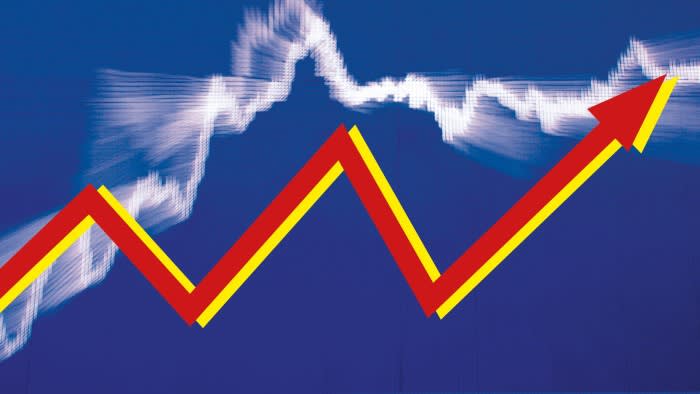First off, thanks to all those FT Weekend Festival-goers who packed out the Money tent on Saturday. No doubt lost trying to find Robert Harris or the live cryptic crossword solve-along, it was kind of you not to scamper when I mounted the stage.
It explains the high-level questions, though. And the fascinating show of hands to each of Claer Barrett’s snap audience polls. For example, almost everyone was bearish on stocks over the next five years. I wasn’t joking when I said that made me want to buy, buy, buy!
One smarty pants in the audience asked about emerging market equities, wondering why I’m even curious given the benchmark’s huge exposure to China. It’s a good point, and something I touched on a fortnight ago in this column.
So let’s restart there — as I promised a part two on emerging market shares. We left off with a warning that just because they are cheap versus US equities, this doesn’t make them attractive per se. What matters is their valuation relative to history and fundamentals.
On the former the sirens are hardly screaming “buy”. Emerging stocks — as defined by the MSCI index — are trading on a price-to-earnings ratio of around 15 times. That compares with a 20-year average of less than 13 times.
Given the meltdown in Chinese equities of late, and their 25 per cent weighting in the index, such a premium is hardly encouraging. And one must assume, therefore, that the rest of the benchmark is pricey to boot, with China flattering the overall valuation.
Indeed this is the case. The next biggest country is India, with a one-fifth share of the benchmark. It has a price-to-earnings ratio of 28 times. Taiwan, almost as large, is on 23 times, thanks to semiconductor maker TSMC riding the AI boom and now accounting for half the local index.
But as the audience member above reminded everyone (he knew my portfolio better than I did), I’m already up to my gills in Chinese, Indian and Asian stocks as I own an MSCI EM Asia fund. I am happy with this 19 per cent weighting but no more please.
That is why I am drawn to MSCI’s emerging market ex-Asia index. It covers 15 countries and 243 large and mid-cap stocks. They would give me exposure to about 85 per cent of the market capitalisation of those markets.
What countries? With Asia gone, that leaves Brazil as the chunkiest part of the index at 23 per cent, then Saudi Arabia at 20 per cent and South Africa at 16 per cent. Mexico is one-tenth. It drops off quickly thereafter.
A proper ragbag — with plenty of ethical and environmental issues to ponder. Luckily, I don’t believe in the divestment of secondary market assets such as equities. Someone has to own the shares. And frankly it’s immoral to abnegate your responsibilities by forcing your voting and engagement rights on to someone else.
Meanwhile, there is much to like about this ex-Asia benchmark. Let’s begin with my favourites: terrible performance and being woefully out of favour. Returns are in negative territory this year and over the past decade too. That takes some doing.
This is why it is so cheap — with a 9.5 times forward price-to-earnings ratio. As well as trading at a one-fifth discount to the main emerging markets index, that’s almost half price versus MSCI World.
To be sure, having fewer countries and stocks makes the ex-Asia benchmark riskier. Volatility, as measured by the annualised standard deviation of monthly returns over the past decade, is 50 per cent higher than the global index.
But in practice what that means to you and me is how much of our money is on the line. The maximum loss (what fund managers like to call “drawdowns” because it doesn’t sound as bad) the index has suffered this millennium is 66 per cent — during the financial crisis.
Then again, the MSCI’s all-country world index fell 58 per cent around the same time. That is hardly a less painful outcome in my opinion. So I don’t mind the volatility of the ex-Asia index, certainly in light of its low valuation and underperformance.
Wait, there’s more — as those telemarking ads used to say (a friend of my wife still works for one and they make millions, let me tell you). Three more things about the ex-Asia benchmark stand out.
Brazilian equities, along with South African and Saudi stocks, are all in the top 10 (out of 30) least correlated markets to America’s over the past two decades, according to Asia Partners. Four countries in my Asia fund also make the cut. If the US tanks, they should all fare better.
UK equities were one of the most correlated, but I digress. I also like that three energy and mining names, Saudi Aramco, Petrobras and Vale, make up almost a tenth of the emerging markets ex Asia index. Owning them means I could ditch my energy ETF, which I hold as an inflation hedge.
Sure, Brazil’s population is forecast by the IMF to grow faster than America’s over the next few years, likewise its economy. But I wrote previously why this doesn’t matter. Rather, I’m impressed that Mexico’s stock market has expanded at a nominal 6 per cent average annual clip over the past 20 years, about twice the country’s nominal output growth.
That suggests to me that bosses there are focusing on their equity holders. Let’s hope other countries follow suit. The problem, however, is that my pension platform offers no emerging market products with an ex-Asia benchmark — just lots of ex-China ones.
Any ideas anyone? Perhaps I’m missing a mutual fund or two. Or are there any investment trusts out there with this benchmark?
The author is a former portfolio manager. Email: stuart.kirk@ft.com; Twitter: @stuartkirk__
https://www.ft.com/content/b141a2f9-74de-42f9-9397-f3806f229bf9


